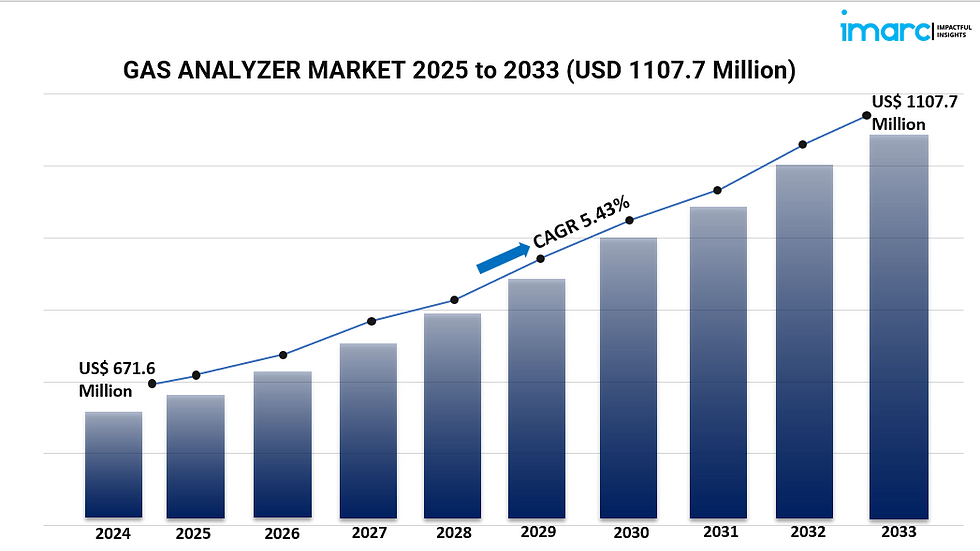Global Beer Industry Analysis,Trends, Growth Opportunities, and Forecast to 2033
- Rahul Pal
- Sep 23
- 3 min read

Beer Market Overview
The global beer market attained a value of USD 686.3 billion in 2024 and is anticipated to reach USD 802.9 billion by 2033, expanding at a CAGR of 1.8% during 2025-2033. The market is experiencing steady growth, driven by shifting consumer preferences toward premium, craft, and low-alcohol beverages, the rise of online alcohol delivery platforms, and a significant boom in the global tourism and hospitality industry.
Study Assumption Years
Base Year: 2024
Historical Years: 2019-2024
Forecast Years: 2025-2033
Beer Market Key Takeaways
Market Size and Growth: The global beer market stood at USD 686.3 billion in 2024 and is projected to reach USD 802.9 billion by 2033, growing at a CAGR of 1.8% during 2025-2033.
Product Type Insights: The market is segmented into standard lager, premium lager, specialty beer, and others. Standard lager leads the market due to its mass-market appeal and wide consumer base.
Packaging Trends: Glass bottles remain the most preferred packaging option, followed by PET bottles and metal cans, reflecting consumer preferences for nostalgia and sustainability.
Production Methods: Macro-breweries continue to dominate the market, while micro-breweries are gaining traction by catering to the demand for craft and artisanal beers.
Distribution Channels: Supermarkets and hypermarkets are the primary sales platforms. On-trade channels like bars, pubs, and restaurants play an important role in premium and experiential beer consumption.
Regional Overview: Europe remains a key market, benefiting from a strong beer culture, advanced brewing practices, and high consumption levels.
Ask for a sample copy of this report: https://www.imarcgroup.com/beer-market/requestsample
Market Growth Factors
Technological Developments in Brewing: The beer industry is adopting advanced technologies to enhance production efficiency and ensure consistent quality. Automated brewing, modern filtering, and updated pasteurization techniques enable extended shelf life and worldwide distribution. Innovative fermentation methods support the creation of diverse beer varieties to meet evolving consumer preferences.
Government Support and Regulations: Governments recognize the economic potential of the beer industry and are implementing supportive policies. Liberalized licensing, tax incentives, and established safety standards encourage new entrants and improve market credibility. Programs promoting responsible drinking also enhance the industry’s image and support sustainable growth.
Changing Consumer Preferences: There is a noticeable shift toward premium, craft, and health-conscious beer options. Low-alcohol and non-alcoholic variants are reshaping the product lineup. Beer festivals, culinary pairings, and experiential events are further enhancing beer’s cultural significance and expanding its global reach.
Market Segmentation
Product Type: Standard Lager, Premium Lager, Specialty Beer, Others
Packaging: Glass, PET Bottle, Metal Can, Others
Production: Macro-Brewery, Micro-Brewery, Others
Alcohol Content: High, Low, Alcohol-Free
Flavor: Flavored, Unflavored
Distribution Channel: Supermarkets and Hypermarkets, On-Trades, Specialty Stores, Convenience Stores, Others
Breakup by Region
North America (United States, Canada)
Asia Pacific (China, Japan, India, South Korea, Australia, Indonesia, Others)
Europe (Germany, France, United Kingdom, Italy, Spain, Russia, Others)
Latin America (Brazil, Mexico, Others)
Middle East and Africa
Regional Insights
Europe continues to lead the global beer market, supported by its long-standing brewing heritage, high per capita consumption, and robust infrastructure. The region’s focus on craft innovation and premiumization ensures consistent demand and dynamic growth.
Recent Developments & News
Anheuser-Busch InBev (AB InBev) reported a 3.4% increase in revenues, reaching $14.8 billion, primarily driven by the rising popularity of premium brands such as Corona and Michelob Ultra.
Despite a volume decline in China, the company recorded growth across North America, Europe, and Latin America, with a noticeable gain in U.S. market share.
Michelob Ultra Zero, a non-alcoholic variant, is gaining traction among health-conscious consumers.
The company’s quarterly adjusted profits rose by 10.1%, surpassing market expectations.
Key Players
Asahi Group Holdings, Ltd.
ANHEUSER-BUSCH INBEV SA/NV
Beijing Yanjing Beer Group Corporation
Carlsberg Group
Diageo plc
Dogfish Head Craft Brewery Inc.
HEINEKEN N.V.
Sierra Nevada Brewing Co.
Grupo Modelo
United Breweries Limited (UBL)
Oettinger Brauerei GmbH
Kirin Holdings Company Limited
Molson Coors Beverage Company
Tetra Laval Group
Customization Support
If you require any specific information that is not covered currently within the scope of the report, we will provide the same as a part of the customization.
Ask Analyst for Customization: https://www.imarcgroup.com/request?type=report&id=1256&flag=C
About Us
IMARC Group is a global management consulting firm that helps the world’s most ambitious changemakers to create a lasting impact. The company provides a comprehensive suite of market entry and expansion services. IMARC offerings include thorough market assessment, feasibility studies, company incorporation assistance, factory setup support, regulatory approvals and licensing navigation, branding, marketing and sales strategies, competitive landscape and benchmarking analyses, pricing and cost research, and procurement research.
Contact Us
IMARC Group 134 N 4th St. Brooklyn, NY 11249,
USA Email: sales@imarcgroup.com
Tel No:(D) +91 120 433 0800
United States: +1-201971-6302






Comments